

- 54. 10 Useful Pieces of Advice for Teaching with LEARNING WORLD #9 & 10
- 55. “Happy New Year!” “I don’t say that.”
- 53. Halloween 2019
- 52. READY Workbook Pg. 17
- 51. English-Uplift 1-Day Seminars
- 50. READY Workbook - vocabulary copying activity
- 49. 10 Useful Pieces of Advice for Teaching with LEARNING WORLD #8
- 48. 10 Useful Pieces of Advice for Teaching with LEARNING WORLD #7
- 47. 10 Useful Pieces of Advice for Teaching with LEARNING WORLD #6
- 46. 10 Useful Pieces of Advice for Teaching with LEARNING WORLD #5
- 45. 10 Useful Pieces of Advice for Teaching with LEARNING WORLD #4
- 44. 10 Useful Pieces of Advice for Teaching with LEARNING WORLD #3
- Kindergarten aged students
- Lower Elementary-school aged students
- Upper Elementary-school aged students
- Junior High and older students
- Others
10. ENGLISH FOR ARTS & CRAFTS
It’s close to the end of the year, and at the school where I teach, each lessons’ regular textbook content has been replaced by Christmas content. The classroom too looks more colorful and magical than usual…

I have tremendous admiration for the school staff. They always decorate the room beautifully AND they research and prepare materials for quite interesting Christmas arts & crafts for the students. In class-time the teachers hand out the pre-prepared materials to the students and give the instructions on how to make it.
In your school, do you do arts & crafts often?
It’s an area I personally don’t have strength in, for two reasons: I’m not overly artistic myself, and I always find it difficult during craft lessons to generate meaningful communication among the students. The teachers I work with often show their students the completed craft sample, then have the students ask for the materials one by one as they make it: “Eyes, please”, “A nose please” “Santa’s hat please” etc. I’m not overly inspired by this interaction because the students all do each step of the craft together and all use the same materials at the same time, so the English is too predictable.
In order to avoid the predictability of English, this year in all my classes, regardless of age and experience, I decided to:
- not show a completed sample
- place all the materials on the students’ table at the start
- not explain how to make it.
With all of the materials ready on their table, I said to the students: “Please start.”
After a moment of uncertainty, they asked “What do we do?”
“Make it,” I answered.
“Make what?” they asked.
Scooting around the question and with my marker on the whiteboard I said “Try this…” :
[ take ] ~
[ put ] ~
Using gestures I reminded the students the meanings of these two actions, and had them practice saying them.
Using materials from the trays on the table, I then showed the difference between
this and these and one of these.
One enthusiastic student, understanding that I wasn’t going to answer the earlier ”Make what?” question, suddenly took the initiative; reaching for the largest piece on the table she asked:
“Take this, yes?”
I instructed students to say “Do we take this?”
And it began…
“Do we take this?”
“Do we put this here?”
“Do we take these?”
“Do we put these here?”
“Do we take one of these?”
“How many do we take?”
“Is this OK?”
I answered each question “yes” or “no” accordingly, and the craft slowly came together.
By all means, check the video. I’m quite happy with the students. As their teacher, I feel their effort to use English is much more important than completing the craft.
9. Hiromi Kawahara-sensei’s “Use of Teaching Materials” Seminar
OK, so hands up all those who went to Hiromi Kawahara-sensei’s (Tokyo) Seminar on Sunday? Well, my hands are certainly raised high above my head right now! What a day!!
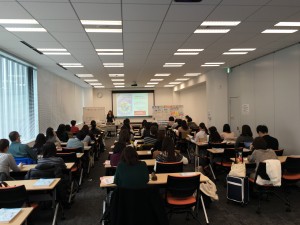
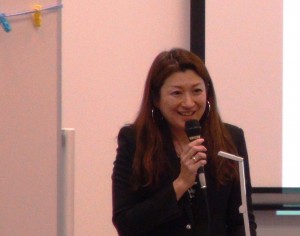
It’s no secret that I’m a big fan of Hiromi Kawahara. She’s one of my “Big Four” most influential teachers (Ron Martin, John Fanselow, Mikiko Nakamoto, Hiromi Kawahara). And on Sunday I felt that she presented the bestest of ALL her best presentations. If you are reading this and you haven’t yet been to any of her workshops, you really should go! And here’s why:
- Her ideas make sense – so they’re easy to understand.
- Everything she says strikes a chord with you, so as she talks you’ll find yourself nodding. Then as you look around, you see so many others in the room involved in the same synchronized nodding movement. She talks about all the things you’ve felt as a teacher but could never quite put your finger on. She describes everything you’ve always wanted to describe about teaching but could never find the words to do so.
- She offers good, very simple classroom ideas – and then expands them further for another few good, very simple classroom ideas. You’re left feeling “Yeah, I think I could do that…” or “I think my students would like that….” or “That’s interesting! What material is that again?”
- She really seems to understand the challenges teachers face, and her advice is practical.
- First appearances are deceiving; she doesn’t fit my “image” of an educator: elderly, soft-spoken with eyes squinted to half-closed during moments of profound depth. She instead rather looks like a fun friend to have a few drinks with. Her deep, deep understanding of children’s English education however, one that she shares a little at a time with you as the presentation progresses, will perhaps surprise you.
- She has total command of all of APRICOT’S materials and readily shares ideas on how to apply them in the classroom.
I chose a couple of scribbles from the notes I made on Sunday to serve as my “best presentation moments”:
- ”For students to produce original ideas and opinions in class, teachers need to present lessons that don’t require merely one answer.” I agree. This thought significantly sets English teachers apart from teachers of other subjects. Until English teachers themselves understand this point, their efforts in the classroom will never produce students capable of worthy English communication.
- ”When teaching with LEARNING WORLD textbooks, in class you open the textbooks last!” This point reminded me of teachers I worked with many years ago who at the start of each lesson would have students open their textbooks at the page where the previous lesson had ended, and resume from there, planning the lesson as they did it. LEARNING WORLD is not a textbook designed for that style of teaching.
I can’t stress enough the value of APRICOT workshops. The insight to be gained there from the experiences of the teachers presenting, as well of course those of the teachers attending, can ultimately make important differences to the experiences of your own students.
Kawahara sensei, Otsukaresama deshita for Sunday! I’m looking forward to seeing you and everyone at next year’s workshops!
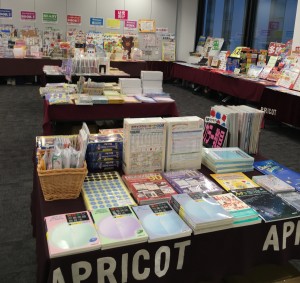
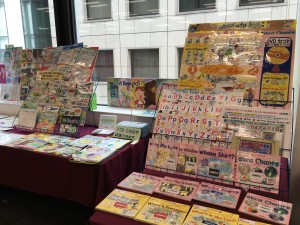
●the next events information ⇒⇒ Click here!
8. Dinosaurs!
I have a fairly new student in one of my upper elementary classes. He is quite shy, and is rarely the first to speak out in class, which is understandable given that his two classmates have four years English experience. Under this condition, opportunities to have him feel success with English are few and far between…
This week, we had the AJ Picture Dictionary open to page 40 & 41 – the dinosaur museum page.
After some general interaction with the students on the contents of these pages, I had the students listen to the vocabulary CD and indicate with their finger on the page the vocabulary they heard: “teeth”, “fins”, “a fossil” etc.
I then gave the students a blank A4 paper and asked them to fold it into 8 boxes. On their shared desk I placed a dinosaur picture book:
*We happen to have this book in our classroom. Googling “dinosaur” and clicking “image” on a class PC or Tablet would be equally effective.
With this book I gave the students a written instruction: “Draw a dinosaur with a long neck”. The students read the task together then searched for a dinosaur with a long neck and drew it on their paper in Box 1. Other instructions followed:
Of course, difficult vocabulary was referred back to AJ, pages 40 and 41.
In the end, the students had drawn 8 dinosaurs on their paper. Below is one student’s drawings:
Pretty good, aren’t they? Certainly much better than my drawing!
Now, below is the new student’s drawings:
Wow, right?! None of us knew that he was so artistically talented! He looked very happy with our outpouring of surprise and admiration.
The lesson may still not necessarily have added confidence to his use of English, but it did add to his feeling of self-esteem…!
7. APRICOT MATES MEETING 2015
I usually don’t like to put my daughters into Daycare on the weekend, however I do if there is something very valuable for me to attend. For teachers like me who are interested in furthering the development of their teaching, APRICOT MATES Meetings are indeed very valuable.
There were two last week: one in Osaka and one in Tokyo. I ran my girls up to the Daycare, and then jumped on the short train ride to Nihonbashi to attend the Tokyo meeting.
The venue at Nihonbashi was a comfortable and welcome alternative to the usual Kyorin Building in Nakanosakaue. Checking the map at Nihonbashi station brought a moment of nostalgia as I noted that Sakamoto and Tokiwa Elementary Schools (two Chuo-ku schools in which I taught for many years) were nearby.
It was great catching up with quite a few teachers whom I hadn’t seen for a while – but I was also quite surprised at the rather large number of new faces! So good to see!
In total, 38 teachers including me.


Now, the program for the afternoon had Nakamoto-sensei and Kawahara-sensei giving training at the same time in adjacent rooms… This was slightly problematic for me because, while I have a number of extraordinary and amazing talents, splitting myself in two in order to be in two different rooms at once is not among them!
*Sigh*
BOTH Nakamoto-sensei and Kawahara-sensei give excellent and very inspiring presentations!!
Dilemma, dilemma… who do I choose?
I decided to study with Nakamoto-sensei because well, it’s not every day that she comes to Tokyo. (Reports from teachers who attended Kawahara-sensei’s workshop suggest that it was as fantastic – as usual.)
Nakamoto-sensei opened her presentation by confessing that she had recently shocked some teachers at seminars because she had chosen to talk about the business aspect of teaching. Those teachers had apparently expected Nakamoto-sensei to be not interested in money, and were disappointed that this wasn’t the case. As I listened, I wondered if I actually knew anybody who was not interested in money…
In case I am ever in the future criticised for the same reason, let me state here clearly that I am personally very happy with money coming my way, particularly if it’s a lot. And as such, I was very happy that Nakamoto-sensei in her presentation shared with us the business side of her career in English education.
Look, Nakamoto-sensei did not give a training session on “how to make money”. Her training was about “how to improve professionalism” and “how to improve the quality of your school” so that you can sustain it in order to continue making a positive difference in our students’ lives. Her message reminded me of the words of my favorite philosopher Jim Rohn: “Your income is always a direct reflection of your value to society. If you want more income, you must deliver more value to society”. Nakamoto-sensei’s presentation gave lots of principles to do just that.
After the training there was a small party with food and drinks provided. I should have perhaps made more of an effort to meet new faces, but found myself with old faces, picking up conversations exactly where we’d left them at the last APRICOT event.
I was very happy to learn at this meeting that some teachers even read this blog!! This is good to know because it corrects a mistaken assumption of mine that “probably nobody was” (!).If you are reading this, by all means, send me your comments, questions or topics that you want me to discuss here via the APRICOT e-mail address, OK?
By good fortune and a lucky train connection I managed to be at the Daycare perfectly on time to pick up my girls. They’d had a great day – and hadn’t missed me in the slightest.
6. A dog! Look! More than one… DOGS!
Page 7 of Learning World Book 3 reminds students of the plural “s” for animal names, as well as introduce new plural forms for animal names that are an exception to the rule: “mouse… mice”, “goose… geese” and “sheep… sheep”.
For a long time I hadn’t really thought about when in English we actually use the plural form for animals aside from as vocabulary for “I like …” However recently the SPRINGBOARD Level 5 book “Kangaroos” gave me some inspiration.
The story inside the book gives some basic facts about kangaroos:
“Kangaroos have a pouch.”
“Kangaroos have a strong tail.”
“Kangaroos can hop.”
“Kangaroos eat grass.”
Using this book as a base, I wondered if my class of 5th graders (minimum of 3 years experience and currently on LW Bk3) would enjoy brainstorming and writing some basic facts about the animals on page 7.
In class, after reading “Kangaroos” together, they decided that:
“Dogs can run”, “Dogs can jump”, “Dogs like balls” and “Dogs like running”.
With class time coming to a close, I asked them to complete “Cats”, “Pigs”, “Mice” and “Geese” for homework. When they presented me with their completed homework the following week, I was very surprised at their ideas:
“Cats eat nori” is this student’s personal observation of his family pet.
His idea “Sheep don’t like dogs” is inspired by another SPRINGBOARD story “Pet Dogs and Working Dogs” (Level 6).
The source of his idea “Mice eat grass” is unknown, but it’s an idea he insists is factual.
This student’s English has in this photo not yet been corrected, but her idea “Geese have teeth” is based on a search on the Internet. I wasn’t aware that geese had teeth!
Expanding a textbook idea to the point where students’ originality can surprise you is actually quite nice, isn’t it?












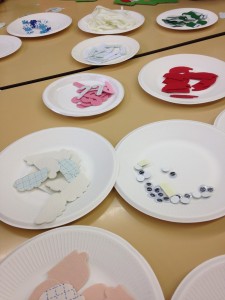
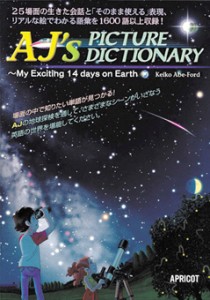
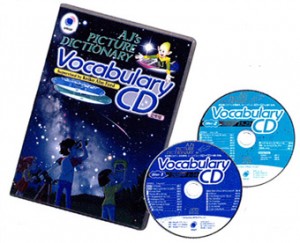
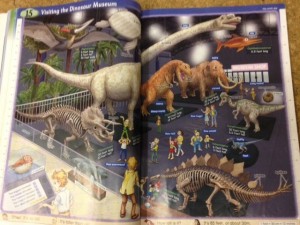
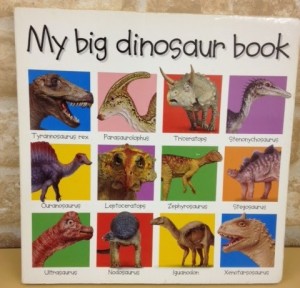
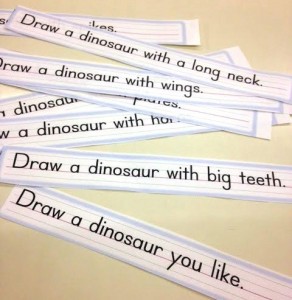
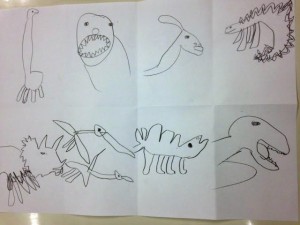 ←Click to enlarge
←Click to enlarge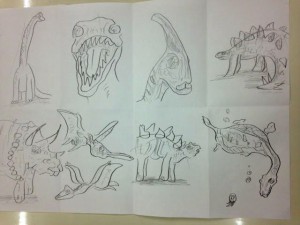 ←Click to enlarge
←Click to enlarge

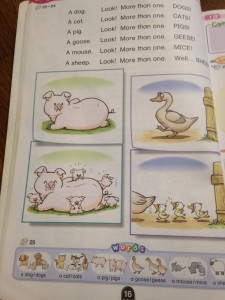
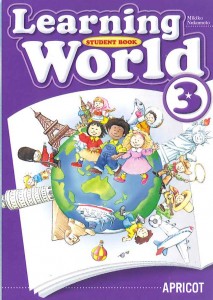
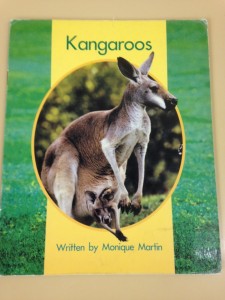
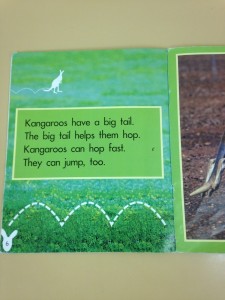
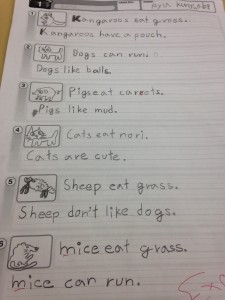 ←Click to enlarge
←Click to enlarge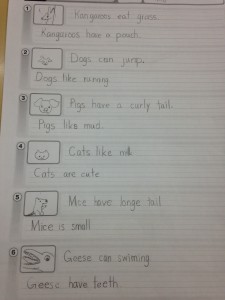 ←Click to enlarge
←Click to enlarge







